How Many Ads Should A Radio Station Run To Get Results? New Analysis From CUMULUS MEDIA | Westwood One And The Radio Advertising Bureau Reveals Guidelines
The Radio Advertising Bureau (RAB) fields questions daily regarding research, best practices, promotional ideas, and more. One of the most frequently asked questions is, “How many ads should I run per week?” The answer always starts with, “That depends. What is your goal?”
The role of advertising is to increase the chance that people will choose your brand by making the brand easy to think of and easy to buy. Yet determining the amount of advertising needed to reach consumers is anything but easy.
CUMULUS MEDIA | Westwood One and the Radio Advertising Bureau partnered to determine and set guidelines based on four campaign goals that range from 34% reach to a 78% reach of a station’s audience.
Using these reach levels as scenarios, the tiers are defined as very light, light, medium, and heavy.
- Very light and light schedules: Ideal for advertisers who want a maintenance campaign with modest levels of reach and frequency.
- Medium schedule: A general sales event or promotional campaign where a good number of listeners are reached often.
- Heavy schedule: A major sales event or product launch where many people are reached very frequently.
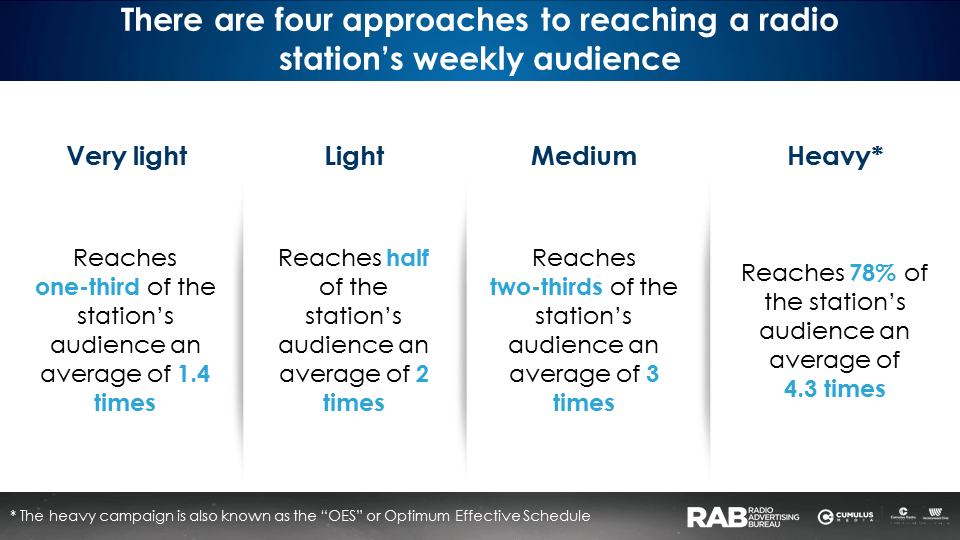
Nielsen reach and frequency reports show the number of weekly ads needed for each of the four campaigns on a typical radio station
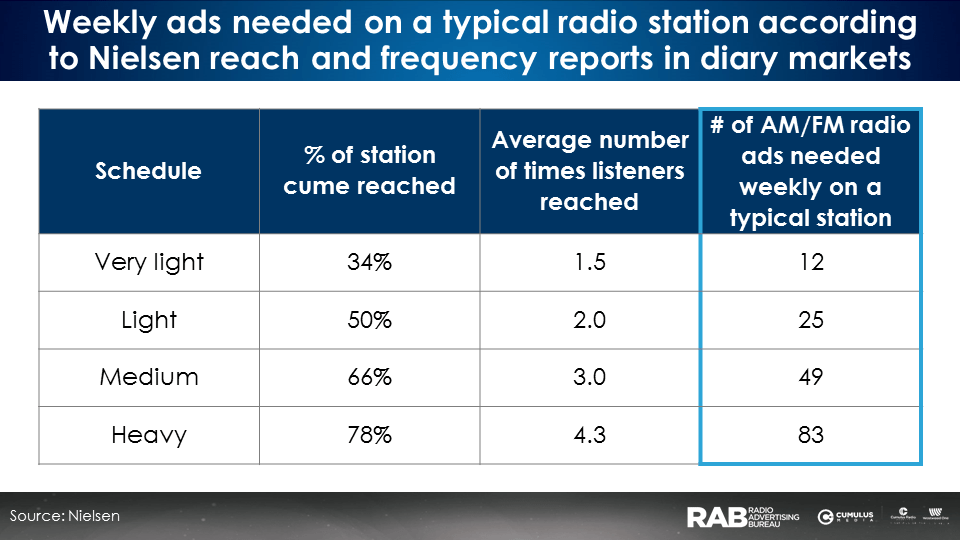
Turnover is the audience metric that determines how many ads are needed to run on a radio station
Turnover is calculated by dividing a radio station’s cume by its average quarter-hour audience. The cume refers to the number of different people reached by a station in a week. The average quarter-hour audience is the number of people listening to a station in a typical fifteen-minute period. Think of the average quarter-hour audience as the number of people reached by one commercial.
Turnover is a ratio that represents the number of groups of people that make up a radio station’s audience. The greater the turnover, the more ads needed to reach the audience. Stations with high turnovers have lower time spent listening (TSL). Stations with lower turnovers have higher time spent listening.
There is no such thing as a good or bad turnover. You just need to know what it is. Turnover is a helpful ratio to understand how many commercials, promos, or song spins are needed to reach a station’s audience.
To determine the number of ads needed for a very light schedule, take half the turnover. For a light schedule, use the turnover. For a medium schedule, double the turnover. For a heavy weekly campaign, multiply the turnover by 3.4.
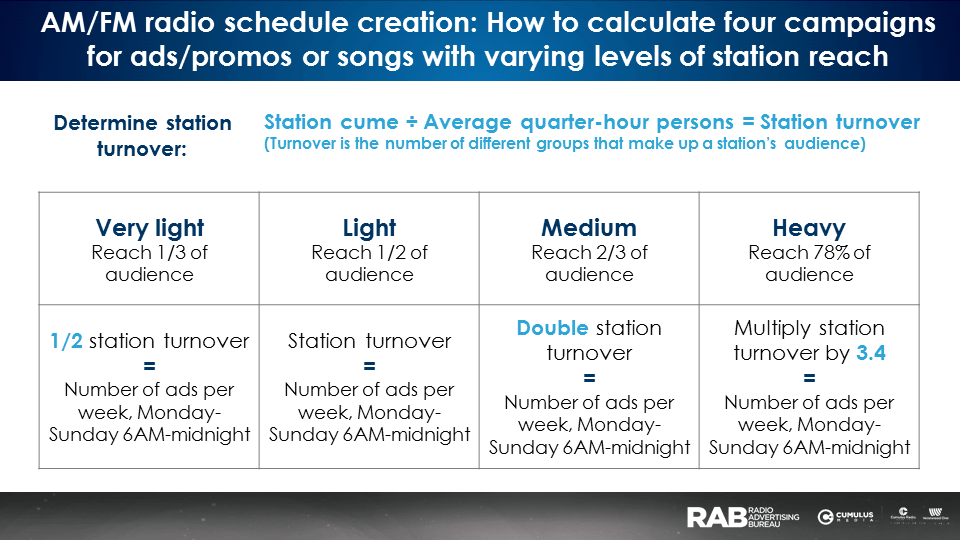
The number of ads needed to achieve each of the four levels of radio station reach varies by AM/FM radio programming format
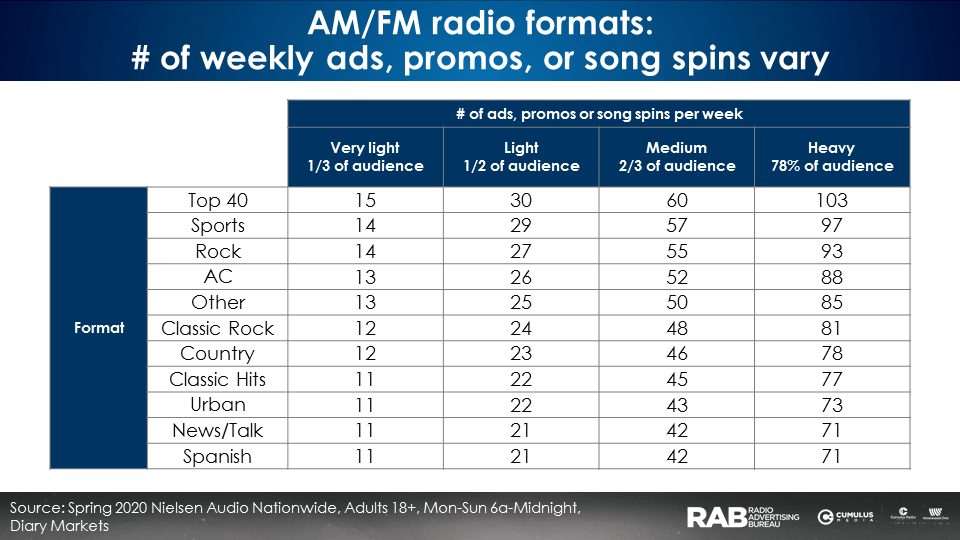
Portable People Meter (PPM) markets turnover: The same number of ads are required yielding different amounts of reach and frequency
Nielsen’s PPM markets generate much higher radio station turnovers due the larger cumes reported by the meter. The same number of ads by format can be run in the PPM markets. The formulas to calculate the four schedules in PPM markets are indicated below.
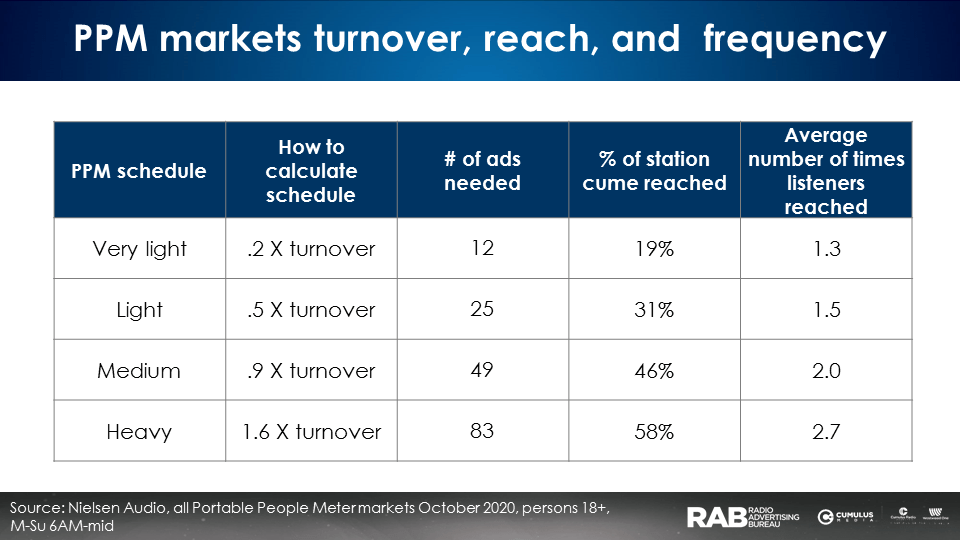
Perception: Agencies and AM/FM radio sellers align on the number of ads needed for light schedules but underestimate the numbers of ads needed for medium and heavy campaigns
In a survey of 334 agencies and AM/FM radio sellers conducted this fall, respondents were asked how many weekly ads would be needed on a station to achieve four levels of station reach based upon the following potential schedule scenarios – very light, light, medium, and heavy. What number of weekly ads did agencies and sellers think was required to achieve each of four schedules?
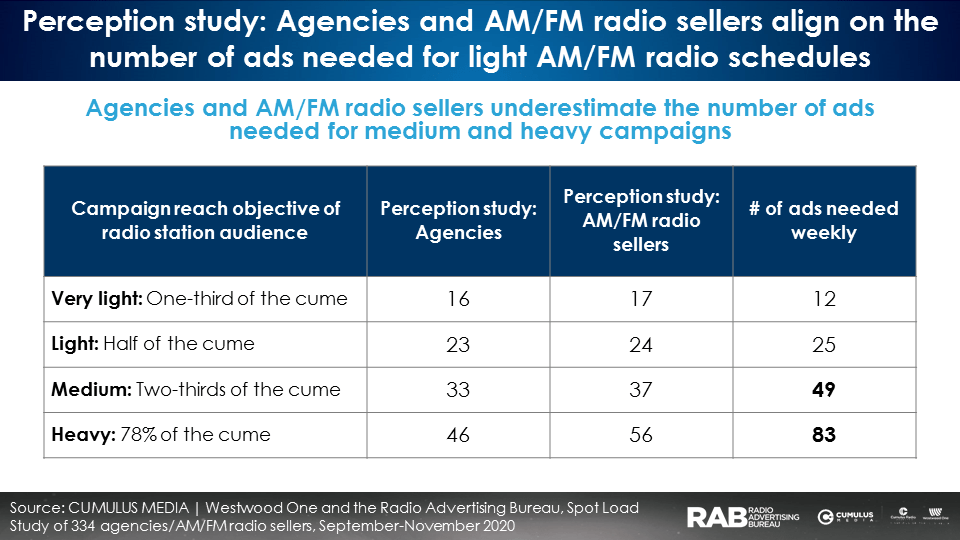
- Very light/light schedules: Agencies and AM/FM radio sellers correctly agree on the number of ads needed.
- Medium schedule: Both agencies and AM/FM radio sellers underestimate the number of ads needed.
- Heavy schedule: Both agencies and AM/FM radio sellers underestimate the number of ads needed.
The gap between perceived and actual ads needed highlights the importance of providing benchmarks and guidelines.
What kinds of campaigns are actually being run?
To understand the prevalence of the four types of schedules, Doug Hyde, Senior Director, National and Local Insights at CUMULUS MEDIA | Westwood One, conducted a Media Monitors analysis of AM/FM radio advertising in 99 markets during a week. Media Monitors captures every ad run on thousands of American radio stations.
During the first week of August 2020, 183,425 commercials were run on 1,685 monitored radio stations in 99 markets. Campaigns were assigned to the four types of schedules: light, very light, medium, and heavy. Station reach and frequency analyses were conducted for all campaigns during the one-week period.
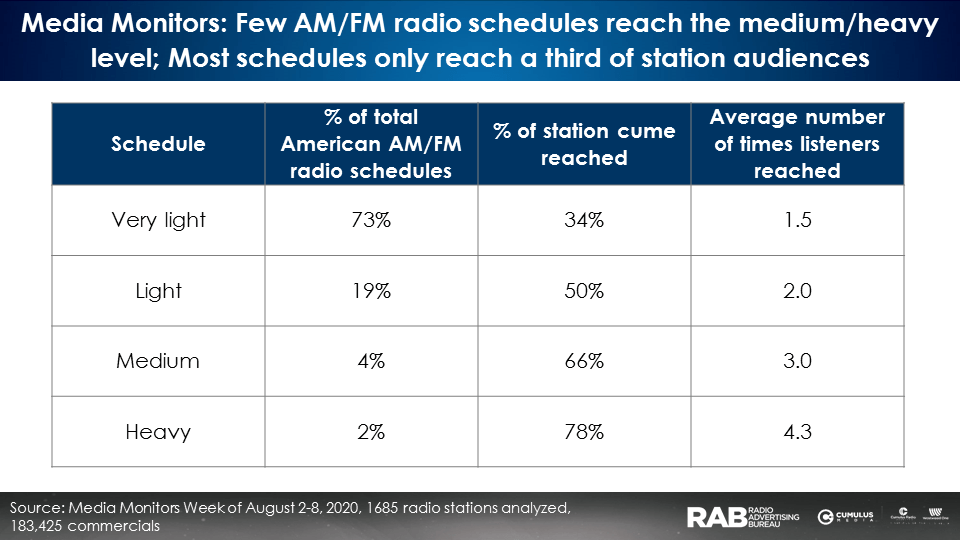
Only 2% of U.S. weekly AM/FM radio campaigns are considered heavy. Only 4% of weekly AM/FM radio campaigns were of medium intensity. Just a fraction of American AM/FM radio schedules reach over half the station audience. The vast majority of weekly radio station campaigns (73%) are very light, reaching only one-third of a radio station’s audience.
It appears that the underestimation of the number of ads needed for medium and heavy schedules is the reason why there are so few medium/heavy campaigns. Heavy campaigns are an important strategy for advertisers. Why?
Advertisers running heavy AM/FM radio schedules are twice as likely to report excellent results
A study conducted a number of years ago by the National Association of Broadcasters and Coleman Insights asked advertisers to rate the results of their recent AM/FM radio campaigns on a scale from “excellent results” to “no results.” They found advertisers running heavy schedules, also called Optimum Effective Schedules (OES), had double the “excellent” rating of their results versus typical advertisers. Optimum Effective Scheduling was invented by legendary advertising expert and revered management and sales trainer Steve Marx.
20% of typical advertisers rated their campaign results as “excellent.” Twice as many advertisers (43%) utilizing the heavy Optimum Effective Schedules rated their campaign results as excellent.
Best practice: Run heavy schedules of AM/FM radio ads in all days and dayparts to generate significant impact
A LeadsRx attribution study commissioned by Westwood One on behalf of a nutrition retailer found that markets with light GRP exposure saw a +7% lift in website traffic. (GRPs are the collection of all the rating points in a schedule. The greater the GRPs, the larger the reach and frequency.) Markets with the heaviest GRP weight from the AM/FM radio campaign saw a massive +16% increase in visitation to the retailer’s web site.
LeadsRx | iHeartMedia: As the number of daily AM/FM radio ads increases, auto dealer website traffic lift surges
The largest AM/FM radio attribution study ever conducted was this study of auto dealer website traffic by iHeartMedia and LeadsRx. LeadsRx studied 310 auto dealers who ran 1.8 million AM/FM radio ads in 100 markets over 17 months. According to the study, auto dealer website traffic surges as the number of daily AM/FM radio ads increases.
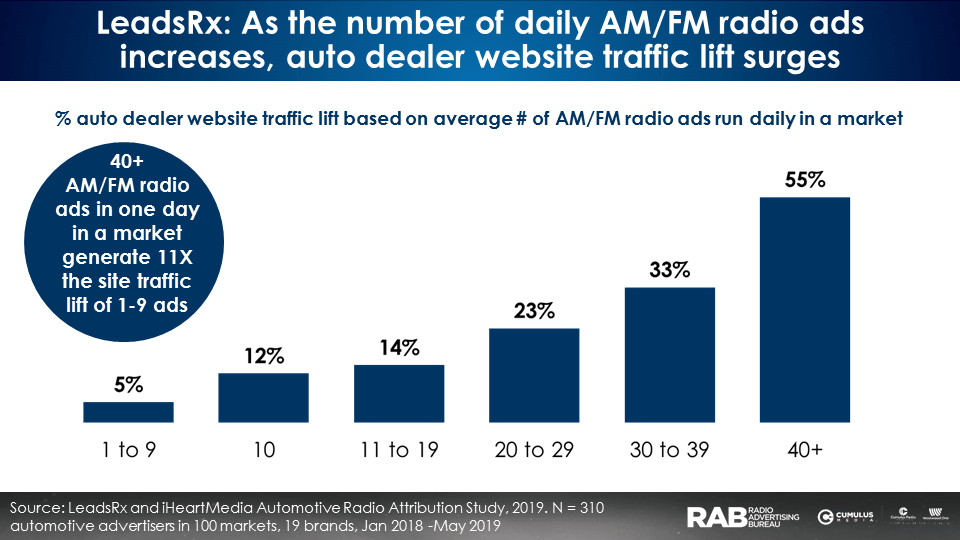
- 1 to 9 ads a day aired in the market generated a +5% lift in auto dealer website traffic.
- 20 to 29 daily ads resulted in a +23% increase in auto dealer website traffic.
- 40+ daily AM/FM radio ads in the market caused a massive +55% increase in auto dealer website traffic.
From the study came three major recommendations:
- Run every day: There is very little difference in web traffic by day.
- Run full week campaigns: Lift doubles when the number of days in a schedule grows from 3-4 days a week to 7 days a week.
- Run lots of ads each day: The more ads run per day in the market, the greater the site traffic. 10 ads per day has twice the site traffic of 1-9 ads per day. 40+ ads per day has eleven times the lift of 1-9 ads per day.
Next steps: How can you put this into practice?
Set the right expectations. Don’t expect grand opening results from a light weekly campaign. The number of people reached and the number of times they are reached impact results. The LeadsRx auto dealer website study reveals the direct relationship between the number of ads and impact.
Advertisers: Examine your annual plan. Does schedule intensity match desired results? Evaluate your annual marketing calendar to insure sales events have sufficient station reach and frequency to drive impact. The number of weekly ads needed for the medium and heavy station schedules is higher than you think. Between sales events, is there a continuous level of advertising to insure your business is “known before it is needed”?
Sellers: Create weekly investment levels for the four campaigns. A grid can be created with the four campaigns across the top from left to right (very light to heavy). (Don’t forget that the number of weekly ads needed for the medium and heavy schedules is higher than you think.) Down the left can be combinations of various ad lengths and time periods/days. This one pager allows you to build proposals based on desired client outcomes, ie. if a client wants a maintenance campaign with modest level of persons reached or if the client objective is for a major sales event with a significant number of consumers reached many times.
Quadruple the number of ads for only a +50% greater investment. “How can I afford the large number of ads required for the medium and heavy schedule?” is a natural and common reaction. Here are two strategies to dramatically increase the number of weekly ads without breaking the bank:
- Run shorter ads. Fifteen-second ads generally cost about half of sixty-second ads. Let’s say you currently run 15 sixty-second ads a week. For about the same investment, you can run 30 fifteen-second ads. Feature sponsorships of news, weather, traffic and sports offer shorter ads that can build reach and frequency.
- Run ads during all days and time periods. Ad costs for nights/weekends generally run about half of drive time/prime time. The LeadsRx study revealed exceptionally strong results from running during all days and time periods.
An advertiser running 15 sixty-second drive/prime time ads can achieve 60 fifteen-second ads running in all days and time periods for only a 50% greater investment. Quadruple the ads for only 50% more.
Don’t underestimate the number of ads needed to achieve specific campaign goals
Delivering the message to the audience and achieving the campaign’s goal is the basic role of advertising. However, based on an analysis of schedules on-air and survey results, the number of ads needed to achieve specific campaign goals is often underestimated.
Remember: Advertising is not “one size fits all.” Understanding the campaign goal is crucial to determining a correct AM/FM radio plan strategy and as important as the message itself. While the number of occurrences/spots needed for various campaign goals might be underestimated, the use of these tools can serve as guidelines to better optimize the AM/FM radio planning and buying process.
Key takeaways:
- Perception: Agencies and AM/FM radio sellers align on the number of ads needed for light schedules but underestimate the numbers of ads needed for medium and heavy campaigns
- Using reach and frequency data, calculating turnover, and understanding differences in AM/FM radio programming formats, the number of ads in the schedule can optimized for maximum impact
- Media Monitors: Only a small fraction of American AM/FM radio schedules achieves heavy or medium reach levels while the vast majority of weekly radio station campaigns are very light
- National Association of Broadcasters and Coleman Insights: Advertisers running heavy AM/FM radio schedules are twice as likely to report excellent results
- Best practice: Campaigns with AM/FM radio ads in all days and dayparts generate stronger results
- LeadsRx | iHeartMedia: As the number of daily AM/FM radio ads increases, auto dealer website traffic lift surges
- Advertising is not “one size fits all”: Understanding the campaign goal is crucial to determining a correct AM/FM radio plan strategy and as important as the message itself
Pierre Bouvard is Chief Insights Officer at CUMULUS MEDIA | Westwood One.
Contact the Insights team at CorpMarketing@westwoodone.com.